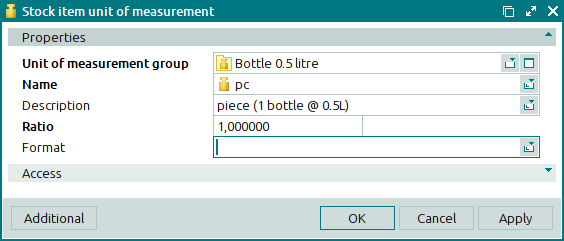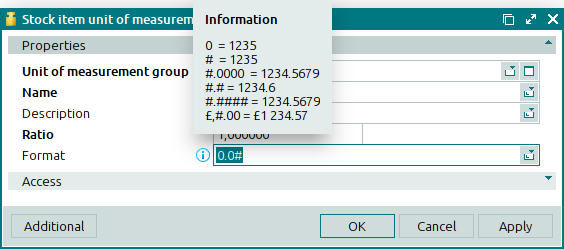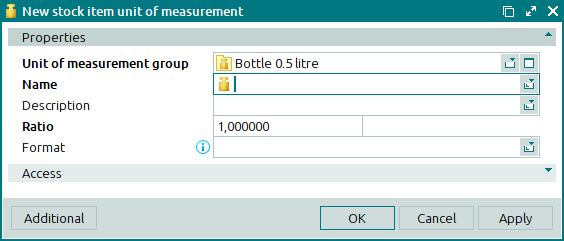© Tillypad, 2008-2015
Windows used to manage units of measurement:
All of these windows are opened from the context menu of the directory.
The editor window is opened by using the command. From here, you can edit one or more stock item units of measurement.
If one unit of measurement is selected, the editor window will open. The window is composed of the Properties and Access panels.

The Properties panel is composed of the following fields:
Unit of measurement group is the name of the group to which the unit of measurement belongs. This is a required field.
Name indicates the name of the unit of measurement. This is a required field.
Description is an optional text description of the measurement unit.
Any additional information can be entered in this field.
Ratio shows the recalculation ratio that sets the relationship between the selected unit of measurement and the base unit of measurement. This is a required field.
The ratio defines the relationship between the primary unit of measurement and multiple supplementary units of measurement, which can be used in the different stock-in and stock-out operations carried out in stores. For example, it is convenient to register vegetables on stores using
kilogrammes, but when you prepare dishes, they are more easily measured ingrammes.For example, if the base unit of measurement is the
litre, the ratio formillilitrewill be0.001, and the ratio forglass will be 0.25. The default value of the ratio is1.Format indicates the number format for displaying stock item quantities expressed in the unit of measurement. The format is applied to directories and store documents.
The symbols
'#','0','.'and','are used to specify formats. The'#'symbol means that only non-trailing zero digits will appear. The'0'symbol means that trailing zeros (zeros in the final decimal position) will also be displayed. The'.'symbol stands for the decimal point. The first decimal point determines where the integer part of the value is separated from its fractional part. All the subsequent decimal points'.'should be ignored. The','symbol is used to divide the integer part of the value into groups of 3 digits (orders of one thousand).The display format also defines the accuracy to which values are rounded. For example, if the number format is
#.00 kg, then2 kgof beetroot will be displayed asbeetroot 2.00 kg, while0.5 kgof carrot will be displayed ascarrot .50 kg.See the table below for more examples:
1234
-1234
0.5
0
0
1234
-1234
1
0
0.00
1234.00
-1234.00
0.5
0.00
#.##
1234
-1234
.5
#,##0.00
1.234.00
-1.234.00
0.50
0.00
These examples can also be displayed by hovering the cursor over the information button next to the Format field.

Click to save data. Selecting will save data without closing the window. Selecting will close the window without saving data.
When multiple records are selected for editing, the multiple editor window opens. A panel with a list of the measurement units is added to the editor window, and the title in the window header changes to .
The fields are similar to those in the editor window.
The entry window is used to add one or more units of measurement to the directory.
The window is opened by using the command or by pasting an element from the clipboard.

The fields are similar to those in the editor window.
The entry window is opened when you paste several stock item types from the clipboard.

